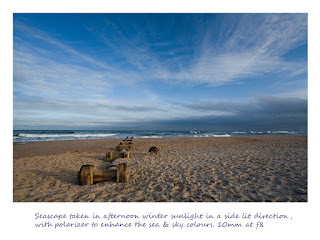
Back to landscape photography. The appeal to me is that the scope for innovation is infinate, because of the light. An unremarkable scene can be transformed to a remarkable one by virtue of the season and the light. This gives infinate permutations. The other draw is my personal wonder at the landscape and it's beauty, I never cease to be amazed at nature's wonders and the colours of the sky. My current circumstances (2 young children and a part time office job) mean that my opportunities for catching the best light in the morning are missed, and I have not yet captured a sunrise, despite living 40 minutes from some beautiful coastline. I hope to rectify this over the next few months before the clocks go forward.
This particular book is a great source of helpful practical tips so I thought I would summarise some of the ones which took me by surprise.
- Including the moon in a landscape shot is difficult, and will record as a white sphere unless taken at twilight or shortly after (it overexposes). Long lenses/ long exposures will also cause some motion blur of the moon. I have only recently mastered shooting the moon, but have not yet managed to incorporate it into a landscape.
- Shadows shape the landscape, giving it texture and form, therefore the direction of light needs to be understood & managed.
- The effects of a polarizer are difficult to mimic through computer processing. The temptation with a polarizer is to have it permanently screwed onto the lens. However there are several problems with that. Firstly it is a 2 stop ND filter in itself. Sometimes that may be desired, but it restricts opportunities for hand held photographs which are always a preference for me. It is also of no use in front lit or back lit situations. At full effectiveness it can cause shadows to block up to full black, and also for rainbows to disappear. Twisting to halfway gives the best outcome in those scenarios, whereby contrast & colour saturation are boosted. A key workflow decision is deciding whether a scene will benefit from having a polarizer attached, and whether to use at full effectiveness.

- Any reading on landscape photography would have you believe that bright overhead midday sun means you can't take pictures. Whilst that may be the case for a lot of situations, it can lead to beautiful coastal scenes, particularly in conjunction with a polarizer, as the overhead light penetrates the depths of the sea. This is a useful tip for me, living near the photogenic North East coast, as it presents opportunities in Summer for landscape photography when the capture of sunrises is impractical for me.
- I have never yet achieved a decent frost tree shot. The conditions I need to look for are a clear blue sky, and combine that with a polarizer.
- Perfect reflections are rare outside dawn or dusk. I can't believe I haven't noticed this before.
- Virtually all lenses perform best between f8 and f11. I have previously used f22, believing that to give greater sharpness, however I will limit this to f16 maximum in future. It is preferable to use filters to block the light rather than a smaller aperture.
No comments:
Post a Comment